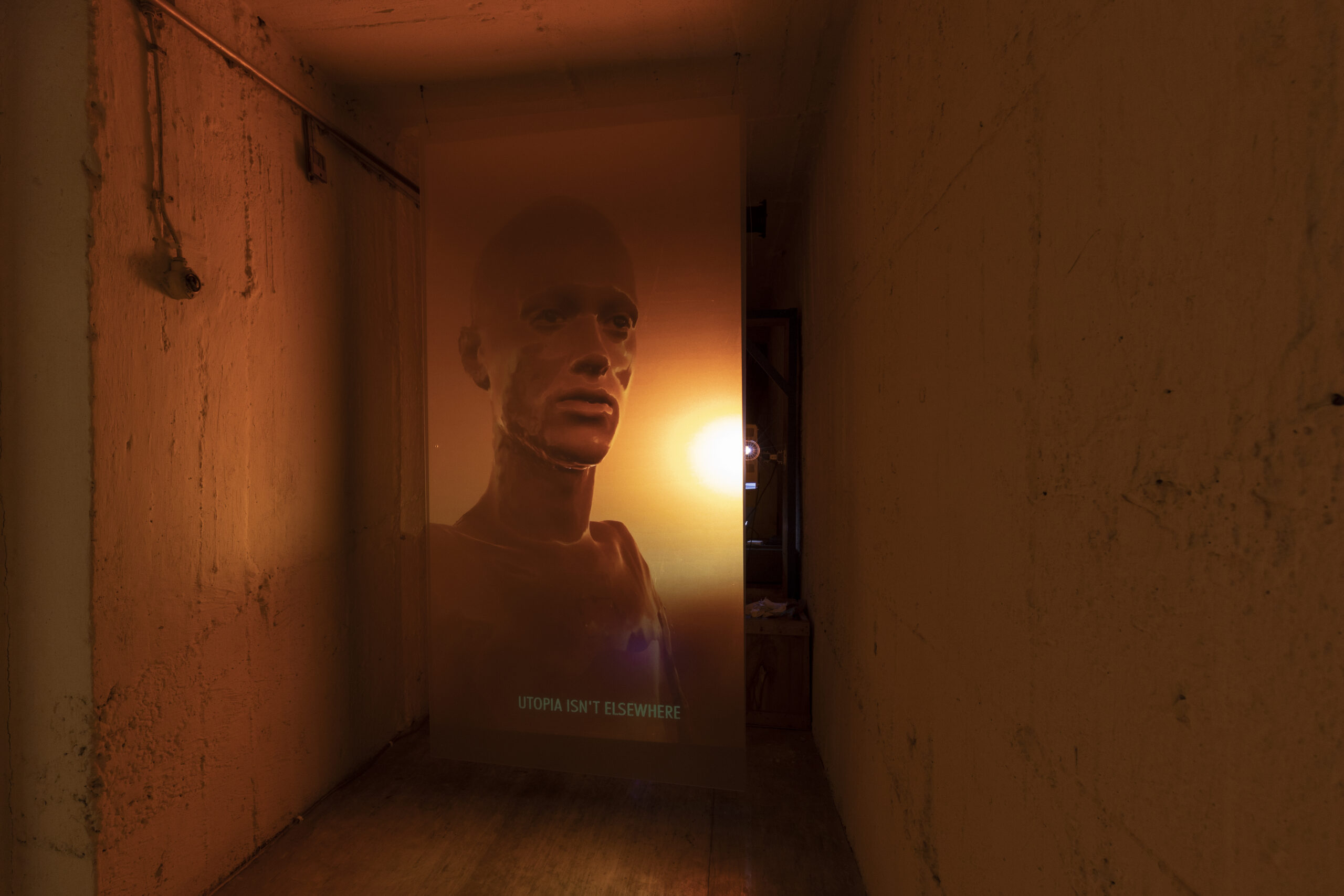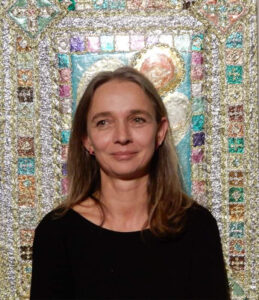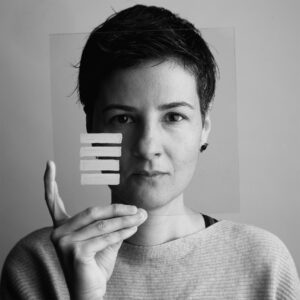Paula Malinowska

– born in 1998, Paula Malinowska is a photographer and 3D artist based in Bratislava, Slovakia. Her work is based on the medium of photography, which she uses to create 3D photogrammetric scans of plant ecosystems. She completed her bachelor’s degree in Jana Hojstričova’s studio at the Department of Photography and New Media and her master’s degree in Martin Piaček’s studio at the Department of Intermedia at the Academy of Fine Arts in Bratislava. She participated on various group shows adn events, including Temporary Connection with a dancing Plant (A Promise of Kneropy, Bratislava, SK, 2022); Kiosk festival 2022 (Žilina, SK, 2022);The Burn Before The Burnout (Karlin Studios, Prague, CZ, 2021); Dissappearing Body (Schaubmar’s Mill, Slovak National gallery, SK 2021); NOWLESSNESS ACT III (Kunsthalle, Bratislava, OFF Festival 2021, SK); Garden Dialogues (Atelier XIII, Bratislava, SK, 2021). In 2022, she participated as a guest artist on Fall Open Studios 2022 in AiR 351 in Cascais, Portugal.
I am convinced that art can make the invisible visible, point out that which is overlooked, question that, what today is considered immutable. I consider creative critical thinking, which is the basis of my artistic approach, a tool for confronting what transcends us. I stand for creativity that is sensitive and engaged. It does not neglect the sociopolitical contexts in which it is located and to which it responds. At the same time, it is the same creativity that does not renounce playfulness and curiosity with which it explores the potential of visual language as a tool for communicating these topics. My work is framed by the shared feeling of the young generation of late capitalism, who lack an alternative in times of a global climate catastrophe and accelerating technological development. My projects have a generative character built on moments of chance. It is the photogrammetry technique, through which I transform physical objects into 3D space, that allows me to develop the unexpected error behaviour that the computer algorithm creates when building the 3D object. I am interested in the creative potential of technologies and the role it can play in the process of finding a new kind of sensitivity towards the planet, a new relationship with it. My artistic research is based on studies in the field of biology, climatology or the development of digital technologies. At the same time, however, I support an intuitive process of creation that could seem in contradiction to these sources of inspiration that are based on the premise of rationalism and logical thinking. I enjoy exploring the mutual relationship between the rational and the intuitive in the hope of connecting them. The words of the French artist Camille Henrot resonate in
me – according to her, myth and science do not necessarily stand in opposition to each other: “Science originates in conviction and faith. What’s more, mythological foundations were very often used to form theories that were later scientifically proven. Faith is often the origin of an intuition that later becomes a physical or a scientific law (…).”1 A myth is something that we don’t usually regard as true. It is an imaginary story anchored outside of our regular reality built on a rational interpretation of the world. However, when we return, for instance, to the ancient mythological stories from the “cradle of the European civilisation”, their metaphors suspiciously remind of the patterns of discrimination present in contemporary society. This is also why, in my art and artistic research, I work with posthumanist theories that fittingly point out the discrimination that had already been present in this ancient world that we consider the origin of democracy.
I am currently dedicated to remaking mythologies of plant metamorphoses, which, in my ongoing project How did Daphne turn into a plant, I place into the context of the 21st century, such as the already mentioned climate catastrophe or the rapid development of technologies. The moment of fusing the human with the non-human is a central motif in my work. At the same time, myths about transformations of women’s bodies are accompanied by a strange kind of friction caused by the element of gender violence, which is an inherent part of myths about plant metamorphoses. Through artistic work, I look for new ways to interpret the stories of plant metamorphoses with an emphasis on the current context of rape culture and the incessant political efforts to regulate our bodily
autonomy. This context is a starting point for the first part of the mentioned project, a short 3D animated film called Our feet, just now so swift, hold fast in resistant roots. Itmaterialises the proposition of a new mythology about the nymph Daphne, which is informed by the history of violence from which it is based, but at the same time does not give up on the search for a new sensitivity to the planet, which, in the effort to fight the current climate crisis, is a necessity. I am thus pointing out that the fight for climate justice
is also a fight for bodily autonomy in times when efforts to control bodies (by numerous laws like abortion laws or the forced sterilisation of trans bodies) affect people all over the world. A critical reimagining of the mythologies that have significantly shaped our perceptions in the past can point to the connection between climate justice and gender justice. We need a new mythology that manifests new ways of relating to the planet, to
non-human actors, to ourselves.
1Camille Henrot “Gross Fatigue” https://vimeo.com/87586331, 20142Image: Still from How did Daphne turn into a plant: Our feet, juts now so swift, hold fast in resistant roots (12:35 min 3D animated short film, made in collaboration with Andrej Žabkay (soundscape); Vladimíra Vrbiňáková (video edit); NaiKavols (voice), 2022- ongoing.
3Image: Still from How did Daphne turn into a plant: Our feet, juts now so swift, hold fast in resistant roots (12:35 min 3D animated short film, made in collaboration with Andrej Žabkay (soundscape); Vladimíra Vrbiňáková (video edit); NaiKavols (voice), 2022- ongoing.
4Image: Still from How did Daphne turn into a plant: Our feet, juts now so swift, hold fast in resistant roots (12:35 min 3D animated short film, made in collaboration with Andrej Žabkay (soundscape); Vladimíra Vrbiňáková (video edit); NaiKavols (voice), 2022- ongoing.
5Image: Still from How did Daphne turn into a plant: Our feet, juts now so swift, hold fast in resistant roots (12:35 min 3D animated short film, made in collaboration with Andrej Žabkay (soundscape); Vladimíra Vrbiňáková (video edit); NaiKavols (voice), 2022- ongoing.
6Image: Screening of How did Daphne turn into a plant: Our feet, juts now so swift, hold fast in resistant roots. AiR 351 Fall Open Studios 2022. Cascais, Portugal, 2022.
7Image: IVY BOOM ( 3:06 3D animated video, made in collaboration with Aneta Bočková (voice); Jelisaveta rapaic (text edit); Ján Siman (sound support), 2021.
8Image: IVY BOOM ( 3:06 3D animated video, made in collaboration with Aneta Bočková (voice); Jelisaveta rapaic (text edit); Ján Siman (sound support), 2021.
9Image: From 'NOWLESSNESS act iii: hot in here event (5:13 3D animated video made in collaboration with Luboš Kotlár, Vladimíra Vrbiňáková, NaiKavols, Matej Grznár, 2021. Event took place in fallout shelter under Kunsthalle Bratislava in november 2021. Photo by Leontína Berková.

– sa narodila v roku 1998. Paula Malinowska je slovenská fotografka a 3D umelkyňa pôsobiaca v Bratislave. Jej umelecká tvorba vychádza z média fotografie, ktoré používa k vytvoreniu 3D fotogrametrických skenov rastlinných ekosystémov. Paula ukončila svoje bakalárske štúdium na Katedre Fotografie a Nových Médií v ateliéri Jany Hojstričovej. Svoje magisterské štúdium ukončila v roku 2022 v ateliéri Martina Piačka na Katedre Intermédií Vysokej školy Výtvarných Umení v Bratislave. Svoju tvorbu prezentovala na viacerých skupinových výstavách a eventoch, ako napríklad Temporary Connection with a dancing Plant (A Promise of Kneropy, Bratislava, SK, 2022); Kiosk festival 2022 (Žilina, SK, 2022), The Burn Before The Burnout (Karlin Studios, Praha, CZ, 2021); Miznúce Telo (Schaubmarov mlyn, Slovenská Národná Galéria, SK 2021); NOWLESSNESS ACT III (Kunsthalle, Bratislava, OFF Festival 2021, SK); Garden Dialogues (Atelier XIII, Bratislava, SK, 2021). V roku 2022 prezentovala svoju tvorbu ako hosťujúca umelkyňa v rámci dňa otvorených ateliérov v AiR 351 v Portugalskom Cascais.
Som presvedčená, že umenie dokáže zviditeľňovať neviditeľné, poukazovať na to, čo je prehliadané. Spytovať to, čo je v súčasnosti považované za nemenné. Kreatívne kritické myslenie, ktoré je základom môjho umeleckého prístupu, vnímam ako nástroj na konfrontáciu s tým, čo nás
presahuje. Zastávam kreativitu, ktorá je citlivá a angažovaná. Neopomína sociopolitické kontexty, v ktorých sa nachádza a na ktoré reaguje. Je to zároveň tá istá kreativita nerezignujúca na hravosť a zvedavosť, ktorými skúma potenciál vizuálneho jazyka ako nástroja pre komunikáciu spomenutých tém. Moja tvorba je rámcovaná zdieľaným pocitom mladej generácie neskorého kapitalizmu, ktorá postráda alternatívu v časoch globálnej klimatickej katastrofy a akcelerujúceho technologického
vývoja. Moje projekty majú generatívny charakter postavený na momentoch náhody. Práve technika fotogrametrie, pomocou ktorej pretavujem fyzické objekty do 3D priestoru, mi umožňuje
rozvíjať neočakávanú chybovosť, ktorú počítačový algoritmus pri budovaní 3D objektu vytvorí. Zaujíma ma kreatívny potenciál technológii a úloha, ktorú môže zohrávať v procese hľadania novej citlivosti a vzťahovania sa k planéte. Vo svojom umeleckom výskume vychádzam zo štúdií z oblasti
biológie, klimatológie, či vývoja digitálnych technológií. Zároveň však zastávam intuitívny proces tvorby, ktorý by sa mohol zdať protikladným ku spomenutým zdrojom inšpirácie založeným na premise racionalizmu a logického myslenia. Baví ma skúmať vzájomný vzťah racionálneho a
intuitívneho so snahou o ich prepojenie. Rezonujú vo mne slová francúzskej umelkyne Camille Henrot, podľa ktorej mýty a veda nemusia nutne stáť proti sebe v opozícii: „Veda vzniká v presvedčení a viere. Ba čo viac, mytologické základy boli veľmi často použité na vytvorenie teórií,
ktoré boli neskôr vedecky overené. Viera je často pôvodom intuície, ktorá sa potom stáva fyzikálnym alebo vedeckým zákonom (…)“1. Mýtus je niečo, čo zvyčajne nezvykneme považovať za pravdivé. Je bájnym príbehom ukotveným mimo našu zaužívanú realitu postavenú na racionálnom zmýšlaní a interpretovaní sveta. Ked sa však vrátime napríklad ku starovekým mytologickým príbehom pochádzajúcim z “kolísky európskej civilizácie”, až podozrivo nám svojimi metaforami pripomínajú vzorce diskriminácie prítomné v súčasnej spoločnosti. Aj preto vo svojej tvorbe a umeleckom výskume pracujem s posthumanistickými teóriami, ktoré na diskrimináciu prítomnú už v antickom svete považovanom za miesto zrodu demokracie trefne poukazujú.
V súčasnosti sa vo svojom prebiehajúcom projekte How did Daphne turn into a plant venujem pretváraniu mytologií rastlinných metamorfóz, ktoré zasadzujem do kontextov 21. storočia, akými sú už spomenutá klimatická katastrofa či rapídny vývoj technológií. Moment zlievania ľudského s mimoľudským predstavuje v mojej tvorbe ústredný motív. Mytologické príbehy o transformáciách ženských tiel zároveň sprevádza akési zvláštne trenie, spôsobené elementom rodového násilia, ktoré je v mýtoch o rastlinných metamorfózach ich inherentným prvkom. Prostredníctvom umeleckej tvorby hľadám nové spôsoby, akými možno interpretovať príbehy rastlinných metamorfóz s dôrazom na súčasný kontext kultúry znásilnenia a neustálych snáh politikov a političiek regulovať telesnú autonómiu. Spomenutý kontext je východiskovým bodom
prvej časti tohto projektu, krátkeho 3D animovaného filmu s názvom Our feet, just now so swift, hold fast in resistant roots. Ten zhmotňuje návrh novej mytológie nymfy Daphné, ktorý je poučený dejinami násilia, z ktorých vychádza, no zároveň nerezignuje na hľadanie novej citlivosti k planéte, ktorá je v snahe bojovať proti súčasnej klimatickej kríze nutnosťou. Poukazujem tak na to, že boj o klimatickú spravodlivosť je rovnako bojom o telesnú autonómiu v časoch, kedy sa snahy o kontrolu tiel mnohými zákonmi (či interupčnými alebo zákonmi o nútenej sterilizácii trans tiel) dotýkajú ľudí po celom svete. Kritické pretváranie mytológii, ktoré historicky do veľkej miery formovali naše vnímanie, môže poukázať na prepojenie klimatickej spravodlivosti so spravodlivosťou rodovou. Potrebujeme novú mytológiu, ktorá manifestuje nové spôsoby vzťahovania sa k planéte, mimoľudským aktérom, k nám samým.
1Camille Henrot “Gross Fatigue” https://vimeo.com/87586331, 20142Obrázok:Záber z filmu How did Daphne turn into a plant: Our feet, juts now so swift, hold fast in resistant roots (12:35 min. 3D animovaný krátky film), vyrobený v spolupráci s Andrejom Žabkayom (zvuková stopa); Vladimírou Vrbiňákovou (strih videa); NaiKavols (hlas). 2022- prebieha
3Obrázok: Záber z filmu How did Daphne turn into a plant: Our feet, juts now so swift, hold fast in resistant roots (12:35 min. 3D animovaný krátky film), vyrobený v spolupráci s Andrejom Žabkayom (zvuková stopa); Vladimírou Vrbiňákovou (strih videa); NaiKavols (hlas). 2022- prebieha
4Obrázok: Záber z filmu How did Daphne turn into a plant: Our feet, juts now so swift, hold fast in resistant roots (12:35 min. 3D animovaný krátky film), vyrobený v spolupráci s Andrejom Žabkayom (zvuková stopa); Vladimírou Vrbiňákovou (strih videa); NaiKavols (hlas). 2022- prebieha
5Image: Záber z filmu How did Daphne turn into a plant: Our feet, juts now so swift, hold fast in resistant roots (12:35 min. 3D animovaný krátky film), vyrobený v spolupráci s Andrejom Žabkayom (zvuková stopa); Vladimírou Vrbiňákovou (strih videa); NaiKavols (hlas). 2022- prebieha
6Obrázok: Premietanie filmu How did Daphne turn into a plant: Our feet, juts now so swift, hold fast in resistant roots. AiR 351 Fall Open Studios 2022. Cascais, Portugalsko, 2022.
7Obrázok: IVY BOOM ( 3:06 3D animované video. vyrobené v spolupráci s Anetou Bočkovou (hlas); Jelisaveta rapaic (úprava textu); Ján Siman (zvuková podpora), 2021.
8Obrázok: IVY BOOM ( 3:06 3D animované video. vyrobené v spolupráci s Anetou Bočkovou (hlas); Jelisaveta rapaic (úprava textu); Ján Siman (zvuková podpora), 2021.
9Obrázok: Z'NOWLESSNESS act iii: hot in here event (5:13 3D animované video vytvorené v spolupráci s Lubošom Kotlárom, Vladimírou Vrbiňákovou, NaiKavols, Matejom Grznárom, 2021). Podujatie sa uskutočnilo v protileteckom kryte pod Kunsthalle Bratislava v novembri 2021. Foto: Leontína Berková.



